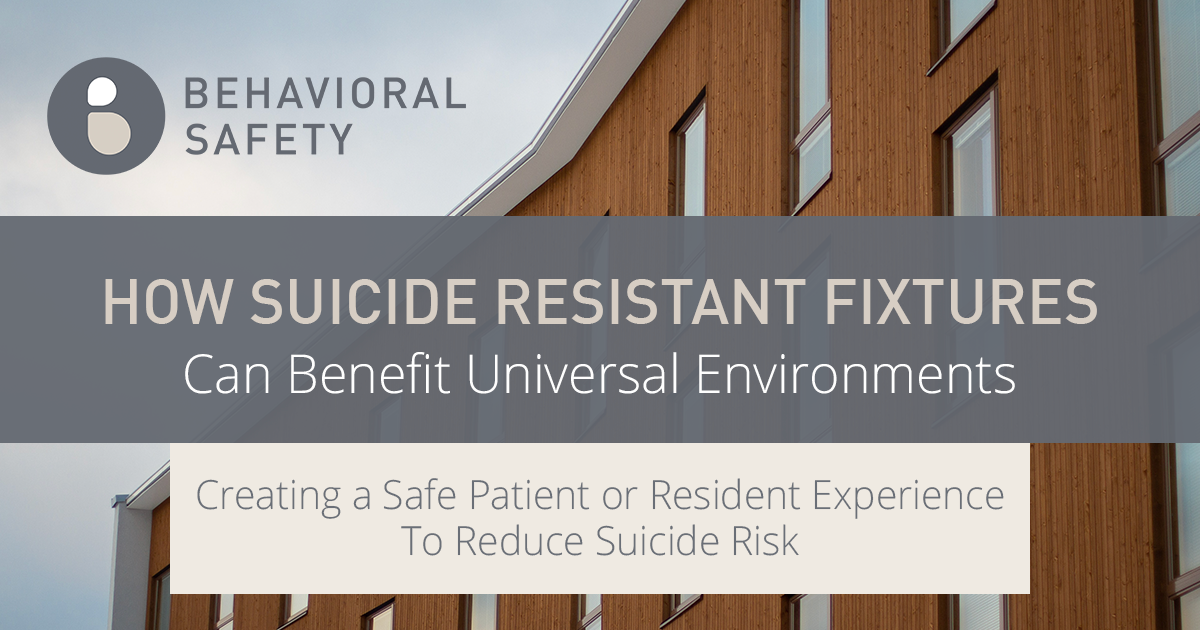Creating a Safe Patient or Resident Experience to Reduce Suicide Risk
Ligature resistant products or fixtures should be implemented in every aspect of a behavioral health facility, especially where mental illness or risk of suicide is a concern.
What about other facilities? Should schools, nursing homes, emergency rooms, prisons, or other environments also be implementing suicide prevention design to keep all those in their care safe?
Ligature resistant products are designed to reduce the possibility of harm by limiting ligature points. For example, a ligature resistant shower head can be designed to reduce the possibility of hanging something to it for the purpose of self-harm. Designing an environment to deter any risks of harm is essential, especially because keeping patients or residents safe in their living space is a primary goal.
While behavioral healthcare professionals anticipate that their patients are at risk of suicide, most facilities do not prepare for that to the same extent. If a living space is safe for every patient or resident, despite suicide risk, it allows for that preventative accommodation.
Here are some places where suicide resistant fixtures or a ligature resistant environment would be highly beneficial:
1. Behavioral, Psychiatric, and Mental Healthcare Facilities
These behavioral facilities have a primary and immediate need for ligature resistant fixtures, with a high percentage of patients having a risk of suicide. Did you know that 73.9% of inpatient hospital suicides occurred during psychiatric treatment? According to a study by the NVDRS and The Joint Commission, between 48.5 and 64.9 hospital inpatient suicides occur each year in the United States.
Ligature points or problem areas in a facility cause opportunities for self-harm or tampering to harm others. According to the Joint Commission, hanging accounts for 70.5% of inpatient suicides. Installing anti-ligature fixtures or ligature resistant products is also conducive to a positive, healing situation for patients.
2. Emergency Rooms and Hospital Patient Rooms
Many people with mental illnesses or suicide risks enter a hospital to seek out care unrelated to their mental health. With an influx of patients with emergencies, it is difficult to provide a truly safe space for each patient without prior knowledge of their situation. If all rooms, bathrooms, or living spaces were ligature or suicide resistant, this would allow for everyone to be accommodated.
While most inpatient suicides occur in behavioral settings, inpatient suicides still occur in hospitals outside of psychiatric treatment. According to The Joint Commission, 14.25% of suicides occur in the non-behavioral units of general hospitals, such as medical or surgical units.
Introducing a universal and accommodating design that helps keep everyone out of harm’s way is a step healthcare facilities can take to encourage safety for all patients.
3. Correctional Facilities, Local Jails, and State or Federal Prisons
The suicide rate in correctional facilities is much higher than the general population. There are many contributing factors, such as the “shock of confinement”, the stressful circumstances, and the likelihood of mental illness in inmates (NIH).
Mental health is a large concern for inmates in correctional facilities, with suicide being the leading cause of death for those in a short-term jail setting. According to the Prison Policy Initiative, approximately 50% of those who committed suicide had been in jail for 9 days or less. It is speculated that certain elements of jail conditions “enhance suicidal behavior” among inmates as well.
While it is impossible for any facility to be fully “suicide-proof”, installing ligature or suicide resistant fixtures in an inmate’s room or bathroom can highly reduce the risk. As discussed in a study by the NCCHC and American Foundation for Suicide Prevention, any objects or fixtures in an inmate’s cell could be used to create a ligature point, sharp object, or ligature device. An environment that is more aesthetically pleasing and allows for better inmate monitoring can also be highly beneficial for both the inmates and correctional facility staff.
4. VA Hospitals and Veteran Campuses
Mental health is often a concern for veterans, especially due to traumatic service experiences or injuries.
According to a study by the NIH, the estimated incidence of PTSD amongst U.S. veterans range from 1.09% to 34.84%. With such a wide range of data, it shows a need for more research and preventative measures for veterans and those who are affected by this mental disorder. Among individuals diagnosed with PTSD, in committed suicides, approximately 54% of those suicides are attributed to their diagnosis. Between October 2017 and September 2019, there were approximately 55 suicides committed by veterans on VA campuses or facilities.
Calm or safe environments are highly beneficial for those in the recovery process, so a ligature resistant design would be helpful in this setting. As PTSD is a prevalent mental illness and is much more likely amongst veterans, these facility design considerations should be prioritized.
5. Schools, Universities, and Resident Dormitories
Suicide is the second leading cause of death among teenagers and college students in the United States, with suicide rates continuing to increase over the years. To help prevent these tragedies, schools have the opportunity to introduce physical safety protocols, provide mental health counselors, and offer resources to those who are struggling.
Among middle and high school students, it is crucial to have a secure environment where there is no adult supervision present. For example, a bathroom that deters any ligature points, tampering, or creating sharp or harmful objects is advised. According to the CDC, suicide is the third leading cause of death for even younger teenagers (age 10-14).
Approximately 1,100 suicides occur on college campuses every year; this is out of the 24,000 average attempts on campus. From 2019 to 2020, it is estimated that 36.9% of students who have sought out student mental health services have contemplated committing suicide.
Many college students leave home for the first time and live in dormitories, which is a big life change. There are many other stressors that come with being a college student, such as peer pressure, potential substance abuse, financial worries, and performing well in school. It is key to properly train and encourage resistant assistants (RAs) to be there for the students living just down the hall from them.
Dormitories often have large community bathrooms, as well as standard fixtures or furniture in dorm bedrooms. Designing a living space that deters the risk of ligature, hanging, or tampering could provide a safer place for students. For example, a suicide resistant desk chair would be a good precaution to take.
6. Nursing Homes and Long-Term Care Facilities
Suicidal thoughts are common amongst nursing home residents, with a study reporting 5% to 33% accounting for suicidal thoughts or ideation. Of suicides committed by assisted-living facility residents, 20% were accomplished by hanging, 17% by falls, and 15% by sharp objects (Caring for the Ages).
Accidental injury can also be a factor, as many residents are unable to care for themselves. A safe environment that is free of purposeful or accidental tampering of appliances can add another layer of protection. A positive atmosphere can also help those who feel isolated or distressed in long-term care facilities.
7. Rehabilitation, Addiction, and Wellness Centers
Mental health is always a concern for those who are seeking help in rehabilitation facilities due to mental disorders, addiction, substance abuse, or other factors. The road to recovery, both mentally and physically, is never easy. This can take a toll on anyone that may feel isolated or defeated by their situation and wellness progress.
It is common for those with mental health disorders to attempt to alleviate their internal pain or suicidal thoughts with drugs or alcohol. Additionally, those who abuse those substances are 10 to 14 times more likely to commit suicide. When those individuals are in a rehabilitation setting attempting to “detox” or remove themselves off of substances or behaviors, it can result in depression or suicidal ideation.
A safe living area for residents of those facilities reduces the risk of suicide. A positive, healing environment can help ease their mind, provide a sense of calm, and also deter self-harm.
—
Suicide is a terrible tragedy in every setting, so it is important to do everything we can to help ourselves and others. If you or someone you know is contemplating suicide, contact the National Suicide Prevention Lifeline at 800-273-8255.
—
With over 45 years of experience in the behavioral healthcare industry, Behavioral Safety Products specializes in designing products for patient environments that promote suicide prevention. Our extensive line of ligature resistant products includes shower heads, shower controls, sinks, faucets, toilets, grab bars, paper towel dispensers, soap dispensers, mirrors, TV enclosures, HVAC enclosures, window shades, door hardware, furniture, and more. Our passion is to save patients’ lives, while improving the quality of their environment by working with facilities, architects, and engineers to be front-runners in problem-solving.

